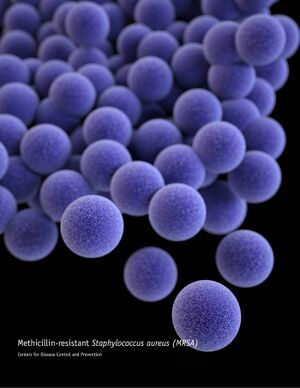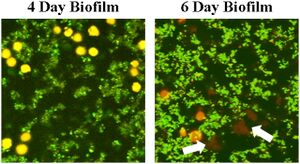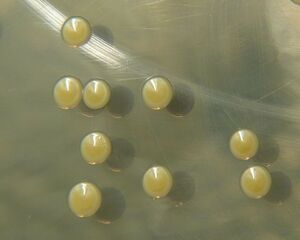Staphylococcus aureus: Evasion of neutrophils
Introduction

Staphylococcus aureus (S. aureus), also known as “golden staph” and “oro staphira", is a member of Bacillota. Staphylo meaning grape in Greek and aureus meaning golden, indicating S. aureus is a kind of yellow-colored, grapelike-cluster of bacteria. [1] [2]
S. aureus is a common type of bacteria that appears everywhere in our daily life and has a high lethal rate all around the world.
S. aureus is commonly found in the environment such as soil, water, and air, and also in the nose and on the skin of humans and animals.[3]
Its high lethality is due to its high antibiotic resistance. In the past, doctors used penicillin to treat patients with S. aureus infection but the antibiotic no longer kills the bacteria by the end of 1940s.
S. aureus is famous for its serious infection reaction in the human body. In order for bacteria to cause infection in the human body, they need to escape from the immune system. S. aureus has developed a number of strategies to survive outside of the immune system before infecting a cell. Besides, S. aureus seems to be inextirpable in that it is resistant to nearly all types of antibiotics. Whenever a new drug is tested against S. aureus infection, it fails after preliminary successes.
The infection of S. aureus is completed within the human body. After S. aureus enters the bloodstream, it will be detected by the immune system. Neutrophils, mast cells and different kinds of immune cells quickly respond to the infection site, causing inflammation reaction and other signaling pathways that command the body to fight against the intruder. While they are still in the bloodstreams, S. aureus have a wide variety of mechanisms to avoid being killed by neutrophils. For example, they release cytotoxic compounds to kill phagocytes which inhibit the function of neutrophils. [1]
Inhibition of neutrophil extravasation, activation, and chemotaxis

Extravasation inhibition
The extravasation of neutrophils includes tethering, rolling, adhesion, crawling and transmigration. [4] S. aureus inhibits these steps by reducing the ability of neutrophils. For example, it inhibits extravasation by interfering with neutrophil rolling. Staphylococcal superantigen-like protein 5 (SSL5), a member of SSL family that is produced by S. aureus is used to prevent neutrophil rolling. The rolling of neutrophil is primarily promoted by P-selectin glycoprotein ligand-1 (PSGL-1), a glycoprotein binding to P-selectin that is found on white blood cells and endothelial cells. [5] Recent research suggested that during infection, SSL5 disturbs the interaction between PSGL-1 and P-selectin by directly binding to PSGL-1 and competing with antibiotics. [6]
Activation inhibition
The activation of leukocytes is also inhibited by SSL5. [7] Chemoattractant, the small molecules that bind to the receptors on leukocytes, act as an important factor in neutrophil activation, including stimulation, polarization, and locomotion.[8] Thus, in order to limit the function of neutrophils, SSL5 also targets chemoattractant. In the process of inactivation, SSL5 interacts with cells by recognizing chemokine and anaphylatoxin receptors on cells’ surface and directly binding to G protein-coupled receptors (GPCRs). In specific, among various kinds of chemoattractant, C3a, C5a, and CXCL8 induced-neutrophil stimulation are inhibited by SSL5. [7]
Chemotaxis inhibition
Chemotaxis, the movement of neutrophils in response to chemoattractant [9], is also inhibited by S. aureus. Research showed that chemotaxis inhibitory protein of S. aureus (CHIPS) is responsible for the inhibition of chemotaxis by specifically targeting and inhibiting the C5a- and fMLP-induced responses. When the gene of CHIPS is identified and knocked-out, S. aureus is not able to prevent chemotaxis. [10] In specific, CHIPS cut down the mobilization or neutrophils by affecting fMLP or C5a and by directly binding to their receptors.
Avoid phagocytosis by aggregation and biofilm formation
Aggregation
During the infection, S. aureus sometimes forms fibrin-containing bacterial aggregates to elude phagocytosis. [1] To achieve agglutination with fibrinogen, S. aureus produces three important products.: coagulase (Coa), von Willebrand factor binding protein (vWbp), and clumping factor (Clfa). The compounds produced by S. aureus, coagulase and vWbp, promote cleavage of Aα- and Bβ- chains of fibrinogen which will then be used by Clfa to bind to fibrin clots and generate fibrin-containing bacterial aggregates. Fibrinogen is a glycoprotein complex that is naturally produced by the human body to stop bleeding and made up of three pairs of three chains of Aα-, Bβ-, and γ-chains. [11] [12] [1]

Biofilm formation
With the assistance of polysaccharide intercellular antigen (PIA), S. aureus forms multilayered biofilm to protect itself from phagocytosis. Within the bacteria cell population, the number of cells is kept at a certain level for S. aureus to metabolize and survive. [13] With the protection of biofilm, the essential cells in the S. aureus population will not be eliminated by macrophages and other immune cells. S. aureus biofilm not only evades TLR2 and TLR9 cognition, but also kills the majority of macrophages that invaded the biofilm. Macrophages that entered matured biofilm appear to have ghostlike and deformed morphology compared to normal macrophages. Also, research discovered dead macrophages that are closely associated to biofilm. One possible explanation for this phenomenon is that biofilm contains large amounts of polysaccharides, eDNA, and protein polymers that are difficult for macrophages to engulf, leading to frustrated phagocytosis [14], the release of toxic chemicals to the environment when phagocytes failed to engulf its target. [15]
Inhibition of opsonization
Surface protein A (SpA)
Opsonization is the second step of phagocytosis. During opsonization, antibodies (immunoglobulins, Igs) are added to pathogens (S. aureus) as tags to be more visible for phagocytes. To avoid recognition, S. aureus produces a kind of surface protein called virulence factor A (SpA). SpA contains several immunoglobulin binding-sites that are able to be recognized by IgG antibodies and Variable Heavy 3 (VH3) idiotype antibodies. [16]. Massive plasmablasts, the precursor of plasma cells, were observed to respond to SpA. Moreover, since nearly all B-cells recognize SpA, the presence of SpA will trigger the production of B-cell, leading the immune response to a wrong track. Therefore, SpA serves as a deceiver to allure antibodies’ activities, uses up B-cell repertoire, and allows S. aureus to survive.
Complement system
In addition to the immune system, the complement system also contributes to opsonization of neutrophils. The complement system consists of several small proteins that are produced by the liver and circulate in the bloodstream. The complement system is affected by a number of proteins produced by S. aureus. The proteins could be recruited to the infection site by antibodies. [17] C3-convertase, one of the important proteins produced by the complement system, is responsible for evaluating opsonization, releasing inflammatory peptides, forming C5 convertase and triggering cytolysis. [18] Additionally, efficient phagocytosis requires opsonic C3 fragments. To disturb opsonization which is performed by the immune system, S. aureus produces the staphylococcal complement inhibitor (SCIN) that blocks C3-convertase from inhibiting all major pathways of the complement system. In details, a recent study showed that SCIN successfully prevented C3b/iC3b deposition and phagocytosis. [19]
Inhibition of neutrophil killing mechanisms
Staphyloxanthin
A brief look at the killing mechanism of neutrophils:
Reactive oxygen species (ROS), including superoxide (O2-), hypochlorous acid (HOCl), and hydrogen peroxide (H2O2) are normally produced by phagocytes to kill the ingested bacteria inside phagosomes. Myeloperoxidase (MPO) and nicotinamide adenine dinucleotide phosphate (NADPH) both function as producers of ROS that kill the bacteria. [20] [21]

Staphyloxanthin is a carotenoids pigment that gives the yellow (golden) color of S. aureus (Figure 4) and is also crucial for the bacteria to withstand oxidative stress. The pigment serves as an antioxidant that functions against molecules like MPO and NADPH. Recent research showed that when crtM, the gene that contributes to the function of carotenoids pigment, was inhibited, S. aureus became more susceptible to ROS, indicated by the decreased survival rate of S. aureus. [22] Therefore, S. aureus phagocyte resistance is due to the antioxidant property that is directly enhanced by staphyloxanthin.
Multiple peptide resistance factor (MprF)
In addition to ROS, when the phagocytes successfully engulf bacteria by phagocytosis, they release plenty of peptides that kill bacteria. Antimicrobial peptides (AMPs), as part of the innate immune response[23], play a role in the elimination of S. aureus inside phagosomes. The effective portion of AMPs is cationic antimicrobial peptides (CAMPs). As suggested by the name, CAMPs are attracted by negative charge due to electrostatic interaction. The majority of bacterial membrane is made of phospholipids phosphatidylglycerol (PG) and cardiolipin, which are both negatively charged. [24] During elimination, CAMPs are said to recognize S. aureus inside phagosomes. To avoid being killed, S. aureus produce multiple peptide resistance factors (MrpF). These proteins exert aminoacylation on PG through a series of chemical reactions and thus reduce the negative charge on the bacterial membrane and weaken the electrostatic interaction.[24] The recognitions of S. aureus by CAMPs are therefore more difficult, allowing the bacteria to evade.
Toxin-driven elimination of neutrophils
In addition to passively avoid elimination, S. aureus actively produces toxic chemicals that directly kill neutrophils. The most significant toxins are: α-toxin (Hla), bicomponent leucocidins, and PSMs.
α-toxin
Staphylococcus aureus α-hemolysin, which is also calledα-toxin, forms pore on the cell membrane. In other words, α-toxin creates holes on the cell membrane and allows outer fluid and different kinds of ions to flow into the cell, disturbing its normal function and eventually kill the cell. α-toxin is not only a chemical that lyses normal cells, such as erythrocyte, but it also fights against immune cells, such phagocytes and neutrophils. One of the mechanisms of S. aureus is the interference of efferocytosis. Efferocytosis is the process of macrophages cleaning up dead neutrophils that are being infected by bacteria. As mentioned above, S. aureus avoids being killed by neutrophils with the help of Staphyloxanthin and MprF,. If the infected neutrophils are not removed from the infection site, S. aureus is likely to keep infecting the cell until neutrophils are fully dead. [25]
Bicomponent leucocidins
Panton-Valentine leucocidin (PVL) is a pore-forming toxin produced by S. aureus. The toxic part of PVL consists of two subunit proteins, LukS-PV and LukF-PV. [26] Recent research suggested that LukS-PV recognize and bind to C5L2 and Ca5 (Ca5R)[26] which are complement receptors that are normally found on a number of immune cells, such as monocytes and Granulocytes.[27] By binding to Ca5 and C5L2, LukS-PV could successfully find neutrophils among many cells at the infection site.
Phenol-soluble modulin (PSM)
S. aureus produces a number of PSMs, including PSMs, PSMα 1-4, PSMβ 1-2, PSMγ, and PSM-mec.[28] Phenol-soluble modulin (PSM) is a type of small protein that participates in cytolysis. Until now, not all kinds of peptides are found to have cytolysis function, but research [29] showed that the PSMα peptides kill neutrophils and rescue S. aureus. After neutrophils phagocytize bacteria, the production of PSMα within neutrophils eventually kill the cell. [29]
Conclusion
When S. aureus enters the body (commonly through skin or food), they travel along the bloodstream and trigger inflammation reactions. The immune cells in the bloodstreams are a major threat to S. aureus. The strategies used by S.aureus to escape the immune system include neutrophils deactivation and elimination, chemotaxis and phagocytosis inhibition, and opsonization suppression. In specific, S.aureus inhibits phagocytosis by aggregation and biofilm formation, produces antioxidant molecules and peptide resistance factors, and kills neutrophils by cytolytic toxins or apoptosis. A better understanding of how S. aureus avoids being killed by neutrophil has great contribution to future prevention and treatment of S. aureus infection, including vaccine development and clinical therapy. The recognition and activity of neutrophils and S. aureus require a series of transduction pathway and biochemical structural analysis. More detailed information about protein function and mechanism requires future research.
References
- ↑ 1.0 1.1 1.2 1.3 Gordon Y. C. Cheung, Justin S. Bae & Michael Otto (2021) Pathogenicity and virulence of Staphylococcus aureus, Virulence, 12:1, 547-569
- ↑ Liu GY, Essex A, Buchanan JT, Datta V, Hoffman HM, Bastian JF, Fierer J, Nizet V. Staphylococcus aureus golden pigment impairs neutrophil killing and promotes virulence through its antioxidant activity. J Exp Med. 2005 Jul 18;202(2):209-15.
- ↑ Agents of Foodborne Illness.
- ↑ Kolaczkowska, E., Kubes, P. Neutrophil recruitment and function in health and inflammation. Nat Rev Immunol 13, 159–175 (2013).
- ↑ Wikipedia: Leukocyte extravasation
- ↑ ovanka Bestebroer, Miriam J. J. G. Poppelier, Laurien H. Ulfman, Peter J. Lenting, Cecile V. Denis, Kok P. M. van Kessel, Jos A. G. van Strijp, Carla J. C. de Haas; Staphylococcal superantigen-like 5 binds PSGL-1 and inhibits P-selectin–mediated neutrophil rolling. Blood 2007; 109 (7): 2936–2943
- ↑ 7.0 7.1 Jovanka Bestebroer, Kok P. M. van Kessel, Hafida Azouagh, Annemiek M. Walenkamp, Ingrid G. J. Boer, Roland A. Romijn, Jos A. G. van Strijp, Carla J. C. de Haas; Staphylococcal SSL5 inhibits leukocyte activation by chemokines and anaphylatoxins. Blood 2009; 113 (2): 328–337
- ↑ Douglas J. Weiss, Bruce Walcheck, in Clinical Biochemistry of Domestic Animals (Sixth Edition), 2008
- ↑ Wikipedia: Chemotaxis
- ↑ de Haas CJ, Veldkamp KE, Peschel A, Weerkamp F, Van Wamel WJ, Heezius EC, Poppelier MJ, Van Kessel KP, van Strijp JA. Chemotaxis inhibitory protein of Staphylococcus aureus, a bacterial antiinflammatory agent. J Exp Med. 2004 Mar 1;199(5):687-95.
- ↑ Wikipedia: Fibrinogen
- ↑ McAdow M, Kim HK, Dedent AC, Hendrickx AP, Schneewind O, Missiakas DM. Preventing Staphylococcus aureus sepsis through the inhibition of its agglutination in blood. PLoS Pathog. 2011 Oct;7(10):e1002307.
- ↑ Archer NK, Mazaitis MJ, Costerton JW, Leid JG, Powers ME, Shirtliff ME. Staphylococcus aureus biofilms: properties, regulation, and roles in human disease. Virulence. 2011 Sep-Oct;2(5):445-59.
- ↑ Lance R. Thurlow, Mark L. Hanke, Teresa Fritz, Amanda Angle, Amy Aldrich, Stetson H. Williams, Ian L. Engebretsen, Kenneth W. Bayles, Alexander R. Horswill, Tammy Kielian; Staphylococcus aureus Biofilms Prevent Macrophage Phagocytosis and Attenuate Inflammation In Vivo. J Immunol 1 June 2011; 186 (11): 6585–6596.
- ↑ [ https://en.wikipedia.org/wiki/Phagocytosis Wikipedia: phagocytosis.
- ↑ Pauli NT, Kim HK, Falugi F, Huang M, Dulac J, Henry Dunand C, Zheng NY, Kaur K, Andrews SF, Huang Y, DeDent A, Frank KM, Charnot-Katsikas A, Schneewind O, Wilson PC. Staphylococcus aureus infection induces protein A-mediated immune evasion in humans. J Exp Med. 2014 Nov 17;211(12):2331-9.
- ↑ Wikipedia: Complement system
- ↑ Wikipedia: C3-convertase
- ↑ Jongerius I, Köhl J, Pandey MK, Ruyken M, van Kessel KP, van Strijp JA, Rooijakkers SH. Staphylococcal complement evasion by various convertase-blocking molecules. J Exp Med. 2007 Oct 1;204(10):2461-71.
- ↑ Klebanoff SJ, Kettle AJ, Rosen H, Winterbourn CC, Nauseef WM. Myeloperoxidase: a front-line defender against phagocytosed microorganisms. J Leukoc Biol. 2013 Feb;93(2):185-98.
- ↑ Clauditz A, Resch A, Wieland KP, Peschel A, Götz F. Staphyloxanthin plays a role in the fitness of Staphylococcus aureus and its ability to cope with oxidative stress. Infect Immun. 2006 Aug;74(8):4950-3.
- ↑ Liu GY, Essex A, Buchanan JT, Datta V, Hoffman HM, Bastian JF, Fierer J, Nizet V. Staphylococcus aureus golden pigment impairs neutrophil killing and promotes virulence through its antioxidant activity. J Exp Med. 2005 Jul 18;202(2):209-15.
- ↑ Wikipedia: Antimicrobial peptides
- ↑ 24.0 24.1 Hwang-Soo Joo, Michael Otto, Mechanisms of resistance to antimicrobial peptides in staphylococci, Biochimica et Biophysica Acta (BBA) - Biomembranes, Volume 1848, Issue 11, Part B, 2015, Pages 3055-3061, ISSN 0005-2736
- ↑ Cohen, T., Jones-Nelson, O., Hotz, M. et al. S. aureus blocks efferocytosis of neutrophils by macrophages through the activity of its virulence factor alpha toxin. Sci Rep 6, 35466 (2016)
- ↑ 26.0 26.1 András N. Spaan, Thomas Henry, Willemien J.M. van Rooijen, Magali Perret, Cédric Badiou, Piet C. Aerts, Johan Kemmink, Carla J.C. de Haas, Kok P.M. van Kessel, François Vandenesch, Gérard Lina, Jos A.G. van Strijp, The Staphylococcal Toxin Panton-Valentine Leukocidin Targets Human C5a Receptors, Cell Host & Microbe, Volume 13, Issue 5, 2013, Pages 584-594, ISSN 1931-3128
- ↑ Wikipedia: C5a receptor
- ↑ Wikipedia: Phenol-soluble modulin
- ↑ 29.0 29.1 Surewaard BG, de Haas CJ, Vervoort F, Rigby KM, DeLeo FR, Otto M, van Strijp JA, Nijland R. Staphylococcal alpha-phenol soluble modulins contribute to neutrophil lysis after phagocytosis. Cell Microbiol. 2013 Aug;15(8):1427-37
Edited by Reina He, student of Joan Slonczewski for BIOL 116 Information in Living Systems, 2022, Kenyon College.
